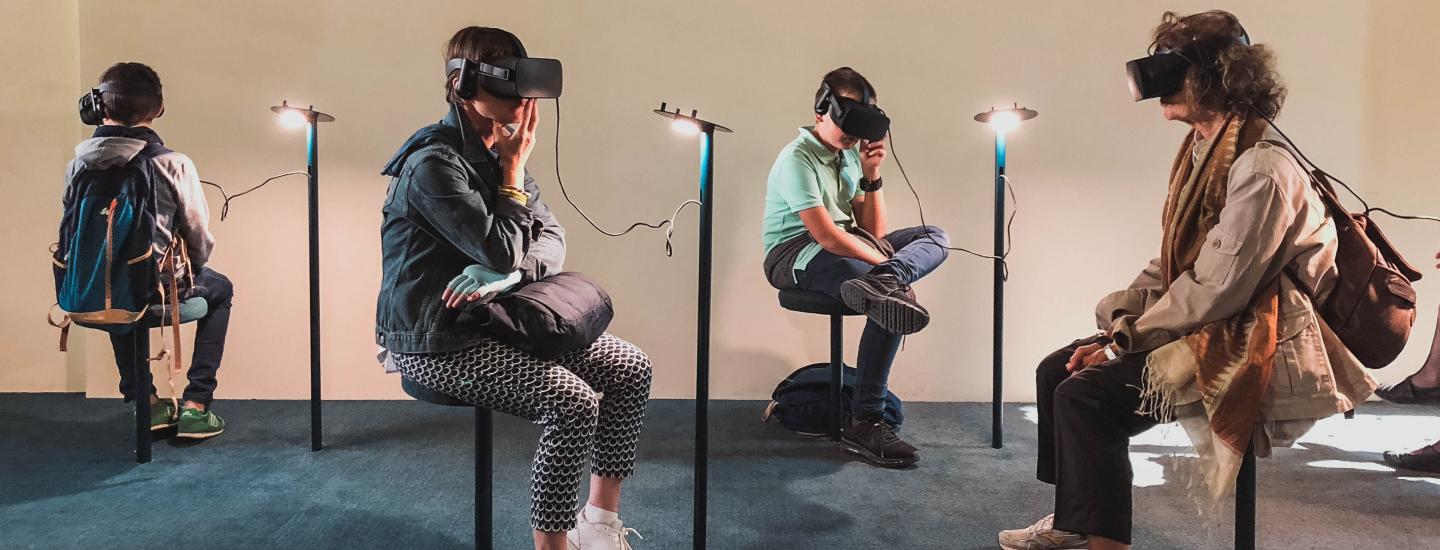
This year’s awards expanded to include nominees in four categories.
Thanks in part to the generosity of author and Creative Writing Certificate Graduate, Marina Nemat, the School of Continuing Studies offers this award to the most promising Creative Writing Certificate student(s) each year. Previously, up to two awards were given each year to the most outstanding Final Project of a Creative Writing Certificate student.
We are excited to share that due to the remarkable growth the Creative Writing program has seen, this year the award has been expanded to include nominees in four categories: Creative Writing in Spanish; Non-Fiction, Children’s/YA; and Multi-Genre.
Four winners will be selected by an esteemed panel of Canadian publishing industry professionals and will receive $1000 each.
This year’s nominees include:
Creative Writing in Spanish

Usanza and Other Stories by María Fernanda Rodríguez A.
Usanza and other stories is a short story collection exploring different realities through everyday scenarios in life. The boundaries between the routine, the ordinary and the rare are shown in these pages, motivating readers to recognize themselves as part of the drama. An emotionless woman in the face of a misfortune, a man who doesn’t recognize himself in front of the mirror, or the risky questions from a little girl trying to understand her parent’s absurd behaviour trigger these stories swings between terror and tenderness.
María Fernanda Rodríguez holds a Master degree in Creative Writing from the University of Salamanca, Spain, and the Certificate in Creative Writing from the University of Toronto. She was the first-place winner of XIV Short stories contest “Nuestra Palabra Canadá 2019”. Her work has been published in literary magazines and anthologies. Currently, she is working on her first collection of short stories, and she is actively participating in literary projects. María Fernanda was born in Quito, Ecuador and now she lives in Toronto with her husband.

El Chincol by Antonio Fernández
El Chincol is an isolated town located in the middle of the imposing Andes Mountains. In this apparently conventional and peaceful town, disappearances and murders take place with disturbing regularity; its inhabitants have learned to coexist with horror and some dark creatures. The six stories that compose this collection are filled with mystery, desolation, and the idiosyncrasy of the Chilean society –––with religion, secrecy, and tradition as the pillars of a broken community.
Antonio Fernández was born and raised in the Andes Mountains, Chile, but has been living in Toronto since 2018. He has published short stories in the books Santiago en 100 palabras (Chile, 2021) and Nostalgia bajo cero (Ottawa, 2020), winner of the 2021 International Latino Books Awards as the best fiction by multiple authors. He has also received the first place for his short story The Lemon Tree at the contest “El Cajón en 100 palabras” (Chile, 2021).

Escudos de carton by Corallys Cordero
Escudos de cartón is a novel inspired by true events. The plot delves into the last twenty-five years of Venezuela through the eyes of characters that represent three different generations. Each of them embodies the struggle to survive in a country torn apart by sociopolitical violence and anarchy.
Corallys Cordero is a Venezuelan lawyer who served as a labour rights judge for more than 14 years. In 2015, she immigrated to Canada and recently became a Canadian Citizen. In 2021, she received a Creative Writing certificate from the University of Toronto, School of Continuing Studies.
Non-Fiction

Boat Stains (Memoir) by Sahar Golshan
Boat Stains is a coming to language memoir. The narrator is a young woman who was raised in Toronto by two refugees from whom she’s inherited two different stories of displacement. In a quest to understand and be understood, she attempts to decode the stories and establish her own narrative.
Sahar Golshan is a writer, language learner, and the director of the short documentary KAR. Her writing has appeared in Room, The Puritan, and Tongues: On Longing and Belonging through Language. She likes asking questions.

The Touch and Turning (Memoir) by Christina Halliday
A young adult memoir told in three parts, The Touch and Turning is a love story about family and a meditation on the unboundedness of human resilience after trauma. It's about the catastrophe of AIDS in the 1980s; the social hysteria and the stigma of the "gay plague" on a family in a small Canadian city. It's about keeping secrets and grief and how a young woman on the verge of adulthood navigates the accident of an AIDS diagnosis, and the fertile seeds of damage it starts, to live a life that feels like normal.
Christina Arija Halliday is an educator and writer who tries to cultivate the muddy roots of human feeling and emotion in her compositions to encourage her audiences to follow with empathy. With a PhD in Education and more than 20 years working professionally in Ontario's postsecondary system, she's rejigging and revising her path at-the-moment so her writing life can emerge more boldly. While her heart is in Calgary, she lives in Toronto in a blended family with her husband and almost-grown children.

Namesake (Memoir) by Charlene Waddell
Namesake is about memories that linger years after the trauma is over. Charlene bumps into her father on public transit after years of estrangement and they try to rekindle what was lost as she considers how to know herself beyond what she's inherited. It's one woman's story about grappling with destiny and the significance of coming from a family with multiple generations of mental illness.
Charlene Waddell is an emerging writer finishing up her memoir manuscript. She is also working on small memoir-adjacent pieces and submitting them for publication. She is a graduate of the Creative Writing program at the University of Toronto School of Continuing Studies.
Children’s/YA

The Garbage Artist (YA Novel) by Mariana Gurgis
Zara Abdelmalek is a fifteen-year-old, bi-cultural, self-proclaimed “garbage artist,” so talented in creating art pieces with recycled materials that her high school art teacher nominates her for an art competition. She must create a piece on how world-changing art can be, and display it at a gala to be judged by a panel of professional artists in order to win a scholarship to a summer art program in Florence–the issue is, she is suffering from a major flare-up with her Crohn’s Disease. While hospitalized, Zara meets Tilly, her unicorn onesie-wearing roommate, who is battling cancer, and whose unexpected friendship empowers Zara to discover that she can turn trash into beauty anywhere, in this coming-of-age story.
Mariana Gurgis is a writer, choreographer, and arts educator. She has a Master of Science degree in Creative Writing from the University of Edinburgh, a Bachelor of Arts degree in English and Philosophy from the University of Toronto’s Victoria College, and she completed a Certificate of Creative Writing at the University of Toronto’s School of Continuing Studies. She is currently writing her first novel, The Garbage Artist, which was awarded a generous grant by the Canada Council for the Arts in 2021.

The Clocksmith (YA Fantasy Novel) by Léa Berry
On a chilled winter morning in 1949, a young woman dressed in peculiar clothes brings Henry, a clocksmith who lost the ability to walk at fifteen, a magical clock that transports him to the past and heals him. As Henry searches for answers, he is reunited with the young woman, Elise, who, in turn, seeks to solve the mystery of her mother’s death. Together, they embark on an adventure to unravel the clocks secrets all the while pushing one another to fight against the social norms of their time.
Léa Berry is a translator currently in her second year of the Specialization in Translation (BA) program at Concordia University in Montréal. With professional experience in ballet, acting and film, she has always had a passion for storytelling. When Léa is not translating or studying, she is working on her novel The Clocksmith, a historical fiction with a hint of magic, inspired by the life of her great-uncle.

Poppy Thomas & the Scriptorium (Middle Grade Novel) by Christina Strasbourg
Wrestling with her grief, eleven-year-old Poppy Thomas is determined to find out what really happened on the day her mother died. Her search is fruitless until she tumbles into The Scriptorium, a magical library filled with a biography for everyone on earth. As she nears the truth about that fateful night, her path will uncloak secrets about her mother, her family and the Scriptorium—and not all secrets are good—leaving Poppy to confront the many facets of her grief, question her identity, and explore what family truly means for the Thomases.
Christina Strasbourg received her Master’s degree in Criminology and never put it to use, preferring to work in communications and parliamentary affairs. Poppy Thomas and the Scriptorium is her first novel and foray into the publishing world. She diligently follows the Oath of the Scriptorium and never leaves the house without a book, not even for a wedding.
Multi-Genre (Fiction and Poetry)

Alphabet: Twenty-Six Letters (Short Fiction) by Jim Colbert
A psychologist is challenged with helping a young man serving time in prison to understand some fundamentals of human interaction and her starting point is to have him explore the notion of fiction: fictions we tell others and fictions we tell ourselves. She shares letters which some of her past clients have written or received involving one or more fiction. Each letter leaves us wanting more of the backstory as well as the need to understand these fictions and on a few occasions the reader is invited to access various websites created to provide both backstory and dynamic content to the stories being told.
Jim Colbert sold his interest in his investment counselling firm in middle age to pursue many personal interests. In recent years the writing component of these pursuits has been the dominant focus and Jim has participated in many writing and poetry workshops, has had poetry published in the South Florida Poetry Journal, and has now completed two manuscripts, one of which is ALPHABET: TWENTY-SIX LETTERS, flowing from the final project at the SCS writing program at the University of Toronto. He lives in Toronto with his wife Janice.

Occasional Bird (Poetry) by Basia Gilas
Occasional Bird is a collection of autobiographical poems about work, childhood, elder care-taking, mentorship and loneliness, duty, listening and unease with love.
Basia Gilas works as a letter carrier with Canada Post in Toronto.

A Wheeling of Antique Moons (Novel) by Emily Hunt
Toronto based psychologist Nimue Abbot loses both her father and husband in the space of two devastating weeks. In the drunken brume that follows, Nimue comes face-to-face with her pattern of emotional dependence upon emotionally absent men, and retreats to her newly inherited childhood haunt, the centuries-old Abbot Cottage, where she plans to heal her wounds, address her dysfunctional patterns, and write a book on the matter. Already occupying the cottage, however, is a man more absent than any of flesh and blood she’s ever encountered, and who may be the unlikely key to the therapy she so needs.
Originally from England, Emily Hunt lives in Toronto with her three sons and their Lovecraftian cat. When not contending with the latter, she reads submissions for the Reservoir Road Literary Journal and writes her own shorts, one of which is forthcoming in Litro magazine. A graduate of the University of Toronto Creative Writing program with Honours, her novel A Wheeling of Antique Moons is currently on submission.

Tyran’s Moon (Adult Fantasy Novel) by C.E. Kinsella
An excerpt from a larger piece, Tyran's Moon serves as the first act in Scarlet Aritza's adventure. We meet our protagonist as she helps execute her sister's vengeance plan against a known abuser. As the piece goes on, she begins to unearth an arcane mystery, meets a queen with a legacy forged by war and magic, and assassinates a man who turns out to be the first domino in a long line that could bring down the entire city.
C.E. Kinsella is a writer of fantasy and horror, and a proud graduate of the University of Toronto's School of Continuing Studies. While not writing about wizardry and political intrigue, she can be found playing Dungeons & Dragons, scouring history books for inspiration, or walking her dog, Strider. She is currently querying Tyran's Moon, now under the title Thief's Gambit, and eagerly waiting for September to arrive, when she'll go on to study history at the University of Toronto.
Congratulations to all of our nominees on their hard work and talent.
For more information about our Creative Writing program, please visit our program information page: https://learn.utoronto.ca/programs-courses/creative-writing.












